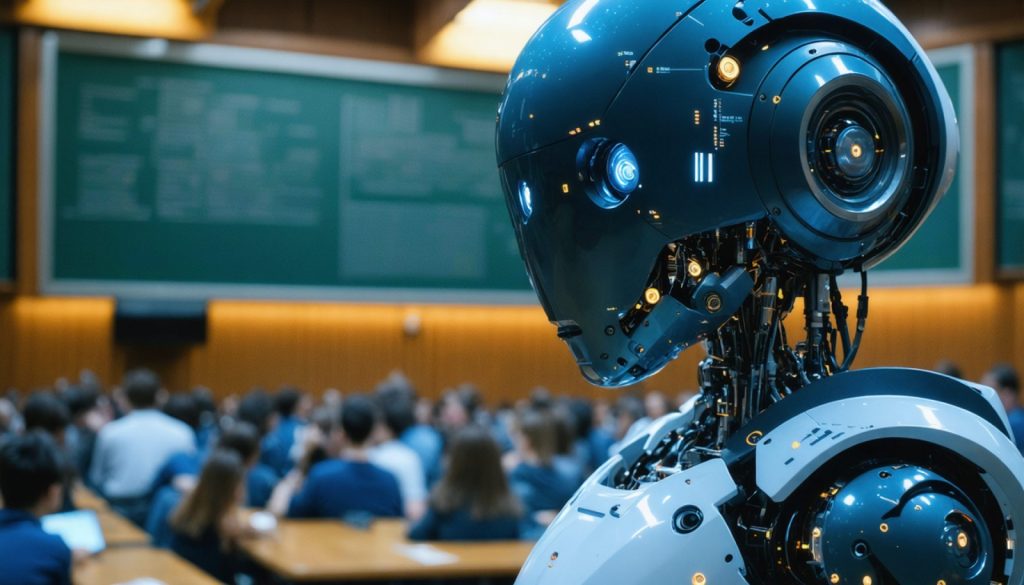
- The integration of AI in education is met with student apprehension, contrasting with educator enthusiasm.
- A Turnitin survey highlights the divergence in perspectives across several countries, including the U.S., U.K., India, and more.
- Students express concerns over AI’s impact on privacy, fairness, and the human element in learning.
- There is worry about AI’s potential to replace human judgment in subjective evaluations.
- Educational leaders see AI as a tool for enhancing access and efficiency, but there’s a need for dialogue with students.
- The challenge lies in balancing innovation with sensitivity to student concerns to avoid alienation.
The seamless blend of AI in classrooms, once envisioned as an educational revolution, now casts a shadow of concern among its most crucial stakeholders: the students. Pulsating through the veins of academia, a new survey from the prominent EdTech firm Turnitin reveals a landscape peppered with unease, especially from the young minds it seeks to enhance.
Traversing the realms of the United States, the United Kingdom, Ireland, Australia, New Zealand, Mexico, and India, the survey unearths a stark divergence in perceptions between students and educators about the role of AI in education. While teachers and administrators often embrace technological advancements as tools of progress, a surprising majority of students raise their voices against this narrative.
The subtle hum of AI, embedded in tools ranging from intelligent tutoring systems to automated grading software, is perceived by students not as an ally, but as a potential adversary. Their concerns pivot around issues of privacy, fairness, and the human touch in a domain becoming increasingly automated. The anxiety is palpable: Will AI supplant human judgment in assessing creativity? How does one ensure that rich, subjective analysis isn’t flattened into binary code?
Academic administrators, ever the torchbearers of innovation, might view AI as a lever to enhance educational access and efficiency. Yet, as this research unfolds, there becomes an urgent call to comprehend the student’s digital discord. It’s a cautious reminder—the quiet before a possible storm—that as we race towards technological integration, the heartbeat of academia, its students, must not be left unheard.
The clear takeaway from this poignant narrative is simple: While AI holds the promise of an educational renaissance, its application demands sensitivity and dialogue with those who stand to inherit its legacy. To proceed without such engagement risks not only alienating the very people these innovations aim to help but also fostering distrust in an era hungry for hope and empowerment.
AI in Education: What Students Really Think and How to Address Their Concerns
AI integration in education is often hailed as the future of learning, promising personalized education, improved efficiency, and innovative teaching solutions. But a recent survey by Turnitin highlights a growing concern among students, who are expressing unease about AI’s role in their education journey. Let’s delve into the profound questions and insights this presents, understand the nuances, and determine actionable steps moving forward.
Key Concerns About AI in Education
1. Privacy and Data Security: Students are worried about how their data is being collected, stored, and used by AI systems. Safeguarding personal information is paramount, especially in educational settings where trust is crucial.
2. Fairness and Bias: AI systems are only as fair as the data they are trained on. There’s a risk of perpetuating biases that may exist within training datasets, leading to unfair outcomes in grading and assessment.
3. Loss of Human Touch: Education is not just about imparting knowledge; it’s about nurturing creativity and critical thinking. Students are concerned that AI might reduce these subjective elements to mere data points.
4. Autonomy and Dependency: Over-reliance on AI tools could hinder students’ ability to think independently, fostering a dependency on technology over critical human analysis and problem-solving.
Addressing Student Concerns: Actionable Steps
1. Enhance Transparency: Educators and AI developers must ensure that AI systems used in classrooms are transparent. Students should have access to information on how these systems work and how decisions, like grading, are made.
2. Involve Students in AI Development: Incorporating student feedback in the development and implementation of AI tools can address specific concerns and ensure these systems are user-centric.
3. Educate About AI: Providing students with education on AI technology, its benefits, and limitations will empower them to critically engage with these tools and understand their impact.
4. Implement Strong Data Protection Policies: Schools and EdTech companies should implement stringent data protection measures, offering students control over their data and ensuring compliance with privacy regulations.
5. Regular Audits and Bias Checks: Ongoing assessments and revisions of AI systems can help identify biases or unfair practices, ensuring they are corrected promptly.
Real-World Use Cases
– Adaptive Learning Systems: Platforms that adjust content delivery based on individual student performance can personalize learning but also need constant monitoring for bias.
– Automated Grading: This can save time but must ensure it provides meaningful, context-rich feedback rather than relying solely on quantitative metrics.
AI in Education: Future Trends and Predictions
– Increased Personalization: As AI systems evolve, adaptive learning will become more sophisticated, offering highly personalized learning paths for each student.
– Hybrid Learning Models: AI will likely be integrated into hybrid school models, combining in-person and online learning to offer flexible, diverse educational experiences.
Final Thoughts
Embracing AI in education doesn’t have to come at the expense of student discomfort. By addressing these concerns head-on, educators can foster an environment where AI acts as an empowering tool rather than a source of anxiety.
For further insights into technology and education trends, visit EdTech.
Quick Tips for Educators
– Engage students in discussions about AI and its role in education, fostering an open dialogue.
– Regularly update and revise AI systems based on student feedback and technological advancements.
– Implement training programs for educators on the ethical use of AI in education to maximize its benefits and minimize risks.



